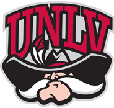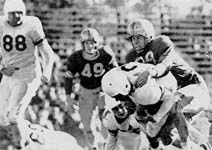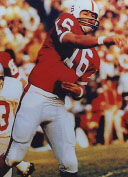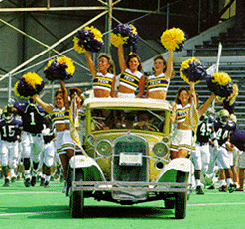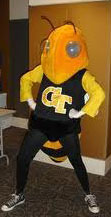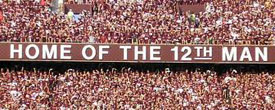CONTENTS
Nearly Unbeatable Vols
When Northwestern Almost Left the Big Ten
A High School with College Facilities
A Big 12 Sleeper
UNLV Traditions
1948 Camellia Bowl
Plunkett Prevails
Cradle of Coaches
Georgia Tech Traditions
Football Doubleheaders
Pro Bowl in Superdome
Origin of the 12th Man
Football:
Did You Know? I
Football: Did You
Know? II
Football: Did You
Know? IV
Football: Did You
Know? V
Football: Did You
Know? VI
Football: Did You
Know? VII
Football Magazine
Golden Rankings Home
Top of Page |
Football:
Did You Know? – III
From
1927 through 1932, Major Robert Neyland's Tennessee
Volunteers lost only one game. That was 18-6 at Alabama
on October 18, 1930. The Vols were unbeated in 33 straight
before that fateful day and then reeled off another 28 game non-losing
span.
Neyland,
a West Point grad who had served in World War I, became head coach in
Knoxville in 1926 when he was an ROTC instructor. He had earlier been
an assistant coach at Army
when General Douglas MacArthur was the superintendent.
After
an 8-1 season in his maiden year – the only loss to Vanderbilt in the second-to-last game – Neyland led his
Vols to the 1927 Southern Conference championship with
an 8-0-1 mark, the ony blemish a 7-7 tie with Vandy.
1928 saw UT win 9 and tie 1, this one a scoreless tie
with Kentucky. That season
saw the resumption of the UT-Alabama
series which has continued unbroken to this day. The Vols'
15-13 win in Tuscaloosa over a team that had just played in the Rose
Bowl brought Tennessee its first national attention.
1929 was soiled only by another tie with UK.
After winning the first three contests in 1930, the Vols
fell to a Bama team led
by Albert Elmore and John Suther.
That season finished 9-1. Then 1931 brought another 9-0-1 campaign,
with another tie in Lexington by the same 6-6 score as two years earlier.
The season ended with a 13-0 victory over NYU at Yankee Stadium in the "New York Charity Game." 1932 was
still another 9-0-1 Southern Conference championship year, the tie to Vanderbilt 0-0.
 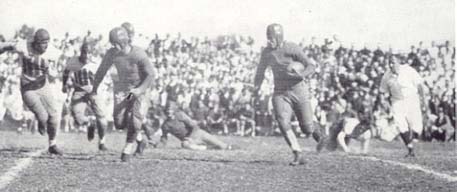 Some
of the stars on those early teams of "The General" were: Bobby
Dodd, who later coached many years at Georgia
Tech and for whom an annual coaches award is named;
Gene McEver (shown above returning the opening kickoff
98 yards against the Crimson Tide
in 1928), UT's first All-American; and Herman
Hickman, an All-American G who later played in the NFL and
coached Yale.
In
the new Southeastern Conference in 1933, the Vols finally
experienced a "down" year: 7-3. They improved to 8-2 in 1934.
Then the first of Neyland's three stints at UT
ended when he was recalled to the Army to serve in Panama.
|
When Northwestern Almost Left the Big Ten
On
November 1, 1955, the campus newspaper of Northwestern
University ran a front-page editorial prompted by the
Wildcats football fortunes
or, more accurately, misfortunes. They were 0-6 after a 49-0 trouncing
by Ohio
State, the Wildcats'
20th straight Big Ten defeat. The last winning season had been 1951,
and that was only 5-4. The next three years went like this: 1952: 2-6-1;
1953: 3-6; 1954: 2-7. New coach Lou Saban had done
nothing to turn around the downward spiral and would be let go after
one 0-8-1 season in 1955. (One of Saban's assistants
was George Steinbrenner.)
Here
is the key excerpt from the Daily Northwestern editorial.
"We
think that, under the present conditions, there are three courses
open:
- Northwestern can let things ride as they are and continue to lose six or seven
conference games each year.
- Northwestern can make some drastic changes in its athletic policies and start
fielding Big Ten caliber teams once more.
- Northwestern can get out of the Big Ten.
We
doubt anyone concerned with the Wildcats'
plight would be in favor of the first alternative ... We think the
third solution is the much more logical."
Northwestern did not, of course, leave the Big Ten. Instead, the school hired Ara
Parseghian from Miami
(OH) to take over the football program. Ara had played
HB at Miami after serving
in the Navy in World War II. He played RB and DB for the Cleveland
Browns (and their legendary coach Paul Brown)
in 1948-9 before an injury ended his pro career. He then coached at
his alma mater under Woody Hayes. When Woody
moved to Ohio
State in 1951, Ara took the reins at
Miami and led the Redskins
(as they were known then) to a 39-6-1 record over the next five years.
Ara
improved Northwestern immediately,
finishing 4-4-1 in 1956 with three conference wins. However, the 1957
squad reverted back to old habits, finishing 0-9. But Ara
got the ship back on course in 1958 for a 5-4 record, including three
Big Ten wins. He then produced these results.
- 6-3
in 1959, including a 45-13
victory over Oklahoma
and a 30-24 triumph at Notre Dame;
- 5-4
in 1960 with another victory over OU,
this one in Norman 19-3, and another one over ND
(7-6);
- 4-5
in 1961 with a third straight win over the Irish,
12-10;
- 7-2
in 1962, including an 18-14 win over his mentor Hayes
and the Buckeyes and
still another ND victory (35-6);
- 5-4
in 1963, including another triumph over OSU,
17-8. (ND was not on the schedule.)
Notre
Dame, mired in the most prolonged slump in its history (19-25
from 1960-1963), decided "If you can't lick 'em, join 'em."
So the Irish hired Parseghian to turn
around their fortunes, which he certainly did, compiling a 95-17-4 record
and three National Championships in 11 seasons in South Bend.
Northwestern later had another bad stretch that made the '50s look good. But that's
a story for another day.
|
A High School with College Facilities
Chase
Daniel led Missouri to a 12-2 record in the
2007 season, including a Cotton Bowl victory, and a #4 final ranking
in the AP Poll. Chase graduated from Carroll
High School in an affluent suburb of Dallas. Homes
there sell for an average of $576,356. The Carroll Independent School
District spares no expense to provide its students the highest quality
educational and athletic experience.
- The
high school's facilities are so nice the Cowboys
have borrowed them.
- The
school has an enrollment of 2,545 and an annual athletic budget of
$500,000.
- The
football team plays in a $15.3 million stadium where crowds average
10,000.
- The
school also boasts a $3.4 million indoor practice facility.
- More
than 350 students play football.
- Reserved
tickets for the season require buying a personal seat license.
The
bottom line is that Carroll
has better facilities than many colleges. The Dragons
have gone 90-2 since 2002 and won four state championships. Their 49-game
winning streak ended during the 2007 season.
Todd
Dodge (former Texas
QB) coached Carroll
from 2000-6, compiling a record of 98-11. Now the head coach at
North Texas, it is debatable whether he enjoys
better facilities there than he had at Carroll.
(The Mean Green's average
attendance in 2007 was 17,734.) Carroll
grads who don't go to big-time colleges play before smaller crowds in
college than they enjoyed in high school.
|
Think
of the Big 12 and you probably think of Oklahoma,
Texas,
and Nebraska
as having the best football tradition. But here are some facts about
another Big 12 school.
-
Since the inception of the Doak Walker Award in 1990
(for outstanding RB), it is the only Division I-A school to have two
different players receive the honor (Byron Morris
1993 and Byron Hanspard 1996). (Ricky Williams
of Texas won it twice in 1997-8 and Darren McFadden of Arkansas in 2006-7.)
- It
is the only Big 12 school to lead the nation in passing three straight
years (2003-5).
-
It is the only Big 12 school that has been bowl eligible in each of
the league's 12 seasons (although they did not go to bowls with 6-5
records in 1997 and 1999). They were also bowl-eligible their last
two seasons in the Southwest Conference for a current streak of 14
years.
- The
school has now played in a school record eight straight bowl games
(2000-2007). This span corresponds to the tenure of the current head
coach.
In
case you haven't guessed yet, the school in question is Texas
Tech. The coach is Mike Leach.
|
|
Nevada-Las
Vegas (UNLV) has one of the youngest football
programs in Division I-A. The school first fielded a team in 1968, 11
years after UNLV was founded and 10 years after basketball
began. The school started in Division II, going 8-1 in the very first
season. They competed in the Big West Conference from 1982-1995 before
becoming a charter member of the WAC in 1996. However, in 1999, UNLV
moved to the new Mountain West Conference.
|
Why
does a Far West school have the nickname "Rebels?" The
school chose the monicker because it thought of itself as stepping
out of the shadow of Nevada-Reno
to the north. Runnin' Rebels was coined in 1974
to refer to the basketball team, which gained national prominence
under Jerry Tarkanian in the 1980s and early
1990s.
In
keeping with its anti-establishment tradition, the school chose
gray, the color of the Confederate military uniforms, and scarlet
from the Confederate flag. The first mascot was a winking cartoon
wolf named Beauregard, who wore a Confederate
cap. After African-Americans protested, he was replaced in the
early 1970s. |
|
In
1999, UNLV became the first college team to win a game
on the last play while trailing and not in possession of the ball. Playing
at home, Baylor led 24-21
with the ball on the Rebel 8 with 8 seconds left. Instead
of having his QB take a knee, Bear
coach Kevin Steele called for a running play. The RB
fumbled and DB Kevin Thomas picked up the pigskin in
the end zone and ran 100 yards for the winning TD.
|
The
Camellia Bowl was played at McNaspy Stadium in Lafayette
LA December 30, 1948. Hardin-Simmons
met Wichita State.
The
Cowboys of Hardin-Simmons,
a Baptist college in Abilene TX, were coached by Warren
Woodson. They had a 4-4-2 regular season record in the
Border Conference. Wichita
State, which finished 5-3-1 for second place in the
Missouri Valley Conference, accepted the other spot when Dayton
turned down the invitation because the Flyers
did not want to miss Christmas with their families and their vacation
jobs. The Shockers' first-year
coach was Jim Trimble, who later coached the Philadelphia
Eagles (1952-55) and the Hamilton
Tiger-Cats of the CFL (winning the Grey Cup in 1957).
|
The
favored Cowboys
outpassed and outrushed WSU
for a 49-12 victory on a clear, cold day before only 5,000 fans.
As a result, the bowl was never played again. (A different Camellia
Bowl was held in the 1960s for lower division teams in Sacramento
CA.)
There
was also a Camellia Bowl Invitiational Basketball tournament in
New Orleans in 1948. Southwestern
Louisiana Institute (the forerunner of today's
ULL) defeated
Loyola (N.O.). A boxing competition was
also held as part of the bowl events.
I've
saved the most interesting feature of this bowl game for last. This
was Hardin-Simmons' third
bowl game of the 1948 post-season! The Cowboys
tied College of the Pacific 35-35 in the Grape Bowl
at Lodi CA on Dec. 11 and defeated Ouachita College
40-12 in the Shrine Bowl at Little Rock Dec. 18. | |
Plunkett Prevails
|
Jim
Plunkett won the 1970 Heisman Trophy after leading Stanford
to a 9-3 season and a Rose Bowl win over Ohio
State.
Jim
had an unusual upbringing because both his parents were blind.
After meeting at a school for the sightless in New Mexico, they
married and eventually moved to San Jose CA where William
Plunkett worked at a Post Office news stand to provide
his wife and three children with a living, although at times they
survived on welfare.
In
his senior year of high school, Jim led his
team to an undefeated season. This earned him a spot in California's
annual Shrine Game. However, the North roster was so stocked with
QBs that he was moved to defensive end! He performed ably at that
unfamiliar position in the game.
He
entered Stanford the following fall. However, he quickly
developed a serious medical problem that required an operation to remove
a tumor on his thyroid. Although the growth proved benign, he was seriously
weakened when he returned to the practice field. Since he had fallen
behind the other three QBs, coach John Ralston, remembering
Plunkett's sterling performance in the all star game,
asked him to move to DE. However, Jim told his coach,
"I am a quarterback."
|
To
regain his touch, he threw 500-1,000 passes a day. Nevertheless, Ralston
redshirted him for his sophomore year. The next year (1968), Jim
seized the starting position behind center. Over the next two seasons,
he threw 34 TDs and gained 4,829 aerial yards. Amid the success, he
suffered another personal setback when his father died.
Since
he had redshirted, he was eligible for the NFL draft after the 1969
season. The chance to earn money to help his widowed mother was tempting,
but he turned it down to return for his senior year. His sensational
final season not only led to college football's most prestigious award
but also made him the #1 overall pick in the draft by the New
England Patriots.
|
Miami
University in Oxford OH is known as the "Cradle of Coaches"
because a nunber of prominent football coaches played or coached there
before achieving greater fame at more prominent college programs or
the National Football League.
- Earl
Blaik played four years
at Miami. He later coached Dartmouth
for seven years and Army
(where he also played two years) for 18. His all-time record of 166-48-14
earned him election to the College Football Hall of Fame.
- Paul
Brown, a member of the Pro
Football Hall of Fame, played two years at Miami
after transferring from Ohio
State. He later coached the Buckeyes
before founding the Cleveland Browns and revolutionizing coaching in the NFL.
He later started another team, the Cincinnati
Bengals.
- Sid
Gillman, also enshrined in
Canton, coached in Oxford before becoming head coach of the
Los Angeles Rams. Considered one of the greatest
innovators in the passing game, he is most known for coaching the
San Diego Chargers.
- Weeb
Ewbank, coach of the Baltimore
Colts 1958 NFL champs and the New
York Jets Super Bowl III winners, played QB at Miami
and coached basketball, not football, at his alma mater. He is enshrined
in the Pro Football Hall of Fame.
- Woody
Hayes, legendary Ohio
State coach, headed Miami's
program before moving to Columbus. He is in the College Football Hall
of Fame.
- Ara
Parseghian played and coached
at Miami before leading Notre
Dame to a 95-17-4 mark. He joined Blaik
and Hayes in the College Football Hall of Fame in
South Bend.
- Bo
Schembechler
played T at Miami and took over as head coach from
1963-8. Of course, he is beloved at Michigan
where he won 13 Big Ten championships in 21 years. The College Hall
of Fame boasts him as an honoree.
- Paul Dietzel was an All-American C at Miami right after World War II. He coached LSU to the national championship in 1958.
- Three
other coaches from Miami:
- Randy
Walker, who was head coach
at Northwestern when
he died in 2006, played three years for the Redskins
(now Redhawks). He also won more games than any
head coach at his alma mater from 1990-8.
- Ron
Zook, one of Walker's teammates in Oxford,
was an assistant in college and the NFL before succeeding Steve
Spurrier at Florida
in 2002-4. In 2007 he coached Illinois
to the Rose Bowl.
- Joe
Novak played and was an assistant coach in Oxford. He
is best known as coach of Northern
Illinois from 1996-2007.
|
The
"Playoff Bowl" was a second NFL post-season game following
the 1960-1969 seasons. Played in the "dead week" between the
championship game and the Pro Bowl, the game pitted the runner-up in
the Eastern Conference against the runner-up in the West. Every one
of the ten games was held in the Orange Bowl to take advantage of Miami's
good January weather. The official name of the contest was the Bert
Bell Benefit Bowl in honor of the league commissioner from
1946-1959.
Here
are the results of the games.
| Date |
Result |
| 1/7/1961 |
Detroit
Lions 17 Cleveland Browns
16 |
| 1/6/1962 |
Detroit
Lions 38 Philadelphia
Eagles 10 |
| 1/6/1963 |
Detroit
Lions 17 Pittsburgh Steelers 10 |
| 1/9/1964 |
Green
Bay Packers 40 Cleveland
Browns 23 |
| 1/8/1965 |
St.
Louis Cardinals 24 Green
Bay Packers 17 |
| 1/9/1966 |
Baltimore
Colts 35 Dallas Cowboys
3 |
| 1/8/1967 |
Baltimore
Colts 20 Philadelphia
Eagles 14 |
| 1/7/1968 |
Los
Angeles Rams 30 Cleveland
Browns 6 |
| 1/5/1969 |
Dallas
Cowboys 17 Minnesota
Vikings 13 |
| 1/3/1970 |
Los
Angeles Rams 31 Dallas
Cowboys 0 |
The
inaugural contest was held after the 1960 season, during which the American
Football League began operation. The first Super Bowl was played after
the 1966 season between the NFL and AFL champions. The following year,
the NFL expanded to 16 teams and subdivided each conference into two
divisions of four. The four division winners entered the playoffs, thus
adding another week to post-season competition. The result was waning
interest in the Playoff Bowl, with players on the competing teams openly
voicing their displeasure at having to play a meaningless game.
The
Packers
played in the game following the 1963 and 1964 seasons. Coach Vince
Lombardi was openly contemptuous of the game, calling it "the
Shit Bowl, ... a losers' bowl for losers." After losing the '65
game, he complained even more. "A hinky-dink football game, held
in a hinky-dink town, played by hinky-dink players. That's all second
place is – hinky-dink." He vowed he would never finish second
again (and he didn't).
The
NFL-AFL merger was completed prior to the 1970 season. After discussing
an extra game between the runners-up in the AFL and NFL, the owners
ended the "losers' bowl" because it was superfluous in the
expanded playoff schedule. The NFL treats the Playoff Bowls as exhibitions
and does not include them in its post-season records. The only vestige
of the Playoff Bowl that remains in today's NFL is the custom whereby
the coaches of the teams that lose in the Conference Finals coach the
Pro Bowl teams.
|
|
Here
are some facts about Georgia Tech football.
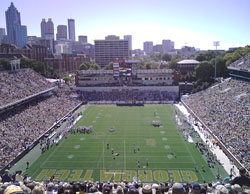
Bobby Dodd Stadium at Grant Field |
- Georgia
Tech is the first school to win all four traditional
major bowls: Rose, Orange, Sugar, and Cotton.
- Its
stadium, Grant Field, opened in 1913, making it the fourth oldest
college football stadium, behind three Ivy League edifices:
Franklin Field, Harvard Stadium, and Yale Bowl.
- Grant
Field is now called Bobby Dodd Stadium/Grant
Field in honor of Tech's legendary coach who
compiled a 165-64-8 record from 1945 through 1966. Included
was a 31-game unbeaten streak starting with the last
two games of 1950 and ending with a loss at Notre
Dame in the sixth game of 1953.
- One
of Tech's unique traditions is that, at away
games, band members ask the stadium's PA announcer to page "George
P. Burdell," a fictitious character in GT
history. In 1927, Burdell's name appeared on
class rosters, registration forms and grade reports.
|
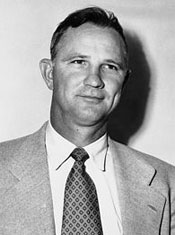
Hall of Fame Coach Bobby Dodd |
|
- The
school has two official nicknames: Yellow Jackets
and Rambling Wreck. The fight song, "Rambling
Wreck," dates to within a few years of the school's origin
in 1888 when a large portion of the student body traveled to
Athens to watch their heroes play Georgia in
baseball. When the song first appeared in print in 1910 in a
compilation of school cheers and songs, the words "hell"
and "helluva" were edited out. The song became so
well known worldwide that U.S. vice president Richard
Nixon and Soviet premier Nikita Khruschev
sang it together in Moscow in 1959. The Yellow Jacket
moniker first appeared in 1905 and referred to the
Tech supporters who wore yellow coats to games.
- The
official Rambling Wreck car made its appearance
at the 1961 home opener and has led the team onto the field
at every home game since. Buzz, the bumblebee
mascot, made his debut in 1980.
|
|
|
There
were a number of occasions in the first 40 years of the 20th century
when a college football team played two opponents on the same
day.
- The
1917 Georgia Tech Yellow Jackets of famous
coach John Heisman defeated both Furman
(25-0) and Wake Forest (33-0) on September
29 in Atlanta. Tech finished 9-0 that year,
outscoring opponents 491-17. Included was a 98-0 shellacking
of Carlisle,
which obviously was not the same power it had been in the "Pop" Warner/Jim Thorpe
era. Heisman's team had defeated
Cumberland 222-0 the year before in
the most lopsided score in football history.
- On
October 9, 1926, Navy
beat Drake 24-7
and Richmond
26-0 in Annapolis. The Midshipmen
won their first nine contests before tying Army
21-21 at Soldier Field before 110,000, the largest crowd ever
to see a football game to that point.
- Michigan
began its 1929, 1930, and 1931 seasons by besting two opponents
on the same day. 1929 began with victories over Albion
39-0 and Mount Union
16-6 en route to a 5-3-1 record. The 1930 victims were Denison
(33-0) and Eastern Michigan
(7-0) as the Wolverines
finished 8-0-1. Finally, in 1931 UM
defeated Central State Teachers
(now Central Michigan)
27-0 and Eastern Michigan
34-0 on October 3 in Ann Arbor en route to an 8-1-1 season,
the loss coming to Ohio
State (which was not the final game of the
season until 1935).
- Wisconsin
went Michigan
one better by playing doubleheaders each year from 1928-31.
After opening 1928 with a 22-6 victory over Notre
Dame, the Badgers
defeated Cornell College
(IA) 49-0 and North Dakota State
13-7 the following Saturday. Wisconsin
began each of the next three seasons with doubleheader sweeps.
1929: Ripon
22-0 and South Dakota State
21-0, half of UW's
wins in a 4-5 season. 1930: 53-6 rout of Lawrence
and 28-0 pasting of Carleton
on October 4 as Wisconsin
finished 6-2-1. Finally, the 5-4-1 1931 season kicked off
with defeats of Bradley
(33-6) and North Dakota State
(12-7). The next week Auburn
came to Madison and tied the Badgers
7-7.
- Still
another Western Conference school, Chicago,
regularly played doubleheaders during this same period, including
two in 1929 (Beloit
and Lake Forest
on October 5 and Ripon
and Indiana State
on October 19). In 1928, the sweep of Wyoming
and Lake Forest
(by only 3-0) provided the only victories of Amos
Alonzo Stagg's season. In 1931, the Maroons
defeated Cornell
(IA) in the opener but lost to Hillsdale
in the nightcap, one of the few times a major school lost
either game of a twinbill.
- Other
Western Conference teams also played two-on-one-day: Northwestern
(1929), Purdue
(1931), and Illinois
(1932).
- The
practice spread to the West Coast during the 1930s. California
played a twinbill every season from 1932 through 1939 with
California-Davis
one of the opponents every year. Southern
Cal obeyed Ernie Banks and
"played two" in 1933 and 1934 as did UCLA
in 1934. Cal's
1939 DH is the last recorded instance of a team playing two
official games on one day.
|
Pro Bowl in the Superdome
The Pro Bowl between the NFC and AFC All-Stars following the 1975 season was played in the newly-opened Superdome in New Orleans on Monday night, January 26, 1976. The game is interesting not only because it was played in N.O. but for two other reasons: (a) the fact that the players seriously discussed boycotting the game and (b) some interesting action that occurred during and right after the contest. First, the controversy that threatened the game.
- Before the Super Bowl in Miami the previous week, Ed Garvey, the executive director of the NFL Players Association, and Kermit Alexander of the 49ers, the president, raised the possibility that the players might boycott the Pro Bowl. The reason was the uncertain status of the NFL's pension plan for the players. "The Pro Bowl is the pension game," said Alexander. "The money is supposed to go to the pension plan. If there's no pension plan, why should the players play in the Pro Bowl."
- The NFL had not contributed to the pension plan for two years because the league had been operating without a collective bargaining agreement since the player strike of 1974. So Commissioner Pete Rozelle would not commit to contributing the proceeds from the Pro Bowl to the pension fund.
- When Garvey met with the players in the Crescent City a week before the Pro Bowl, he updated them on the issues with the league but found most of them inclined to play. "I'm pretty sure it's going to be played," said Terry Metcalf of the St. Louis Cardinals. "I think it's a privilege to be invited."
- A few days later, the players voted almost unanimously to play. Dallas S Cliff Harris probably spoke for the group: "It's an honor to play and the fans are hurt if we don't. But we want management to tell us something about the pensions."
Now the game itself.
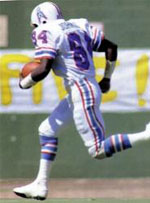
Billy "White Shoes" Johnson
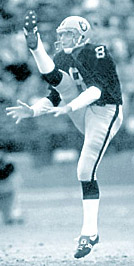
Ray Guy
|
- The uncertainty surrounding the game may have contributed to the small crowd of only 32,108.
- The NFC had a hard time filling the final QB spot on its roster. Minnesota's Fran Tarkenton was picked but had a sore arm. His replacement, Roger Staubach of the Cowboys, had been pounded by the Steelers in the Super Bowl. League officials tried Archie Manning of the host Saints but he begged off with a sore arm. Ditto Atlanta's Steve Bartkowski and James Harris of the LA Rams. So the spot fell to Mike Boryla, a part-time starter for the Eagles, who turned out to be a hero in the contest.
- After a scoreless Q1, the AFC took a 13-0 halftime lead. A 55-yard punt return by Billy 'White Shoes" Johnson of the Houston Oilers set up a 20-yard FG by Jan Stenerud of the Chiefs. Then a 32-yard screen pass from Dan Pastorini of the Oilers to Cliff Branch of Oakland led to a 35-yard FG. Finally, Pastorini hit his teammate Ken Burrough (a former Saint) for a 44-yard TD.
- The NFC fought back with 9 points in Q3. Jim Bakken of the Cardinals kicked a 42-yard FG and his teammate Jim Hart shot a 4-yard pass to the Vikings' Chuck Foreman. The AFC blocked Bakken's PAT to keep the score 13-9.
- Johnson ran back a Q4 punt 90-yards for what is still a Pro Bowl record (as is his 159 total punt return yardage for the game) to extend the AFC lead to 20-9. But Hart drove the NFC to the 14 from where he hit Metcalf for a TD.
- A controversial play in the closing minutes helped the NFC score the winning TD. Steve Odom of Green Bay took a punt at his 10 and lateralled to Detroit's Lem Barney who zipped to the AFC 30. AFC players complained that a whistle had blown before the lateral, causing them to stop.
- Boryla finally entered the game at this crucial point to direct the winning drive which ended with his 8-yard pass to Mel Gray, another Cardinal, with 1:09 left for a 23-20 triumph. Boryla finished second in the MVP voting to Johnson.
- Another interesting play occurred during the game when a punt by Oakland's Ray Guy from his own 10 hit the gondola hanging 90 feet over midfield. Officials made the AFC punt again according to the "ground rules" in effect in the Superdome.
|
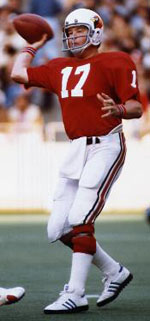
Jim Hart
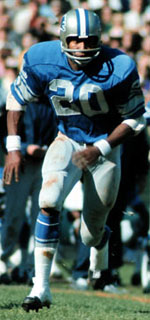
Lem Barney
|
|
The upper deck of Kyle Field proudly remembers Texas A & M's "12th Man" tradition. The story behind the name originates with E. King Gill, a player on the 1921 Aggie football squad who left the team at the end of the regular season to play basketball. However, he attended A & M's Dixie Classic game in Dallas against Centre on January 2. When many of his former teammates fell to injury, Gill was summoned to the field and asked to suit up. He went under the stands and donned the uniform of one of the injured players. Even though the team won 22-14 without him, Gill's willingness to do what he could continues in the tradition of Aggie students standing in readiness for the entire game.
|
|
Follow-up note: Centre arrived in Dallas for the Dixie Classic from San Diego, where it had defeated Arizona in a post-season game a week earlier 38-0.
|
|



